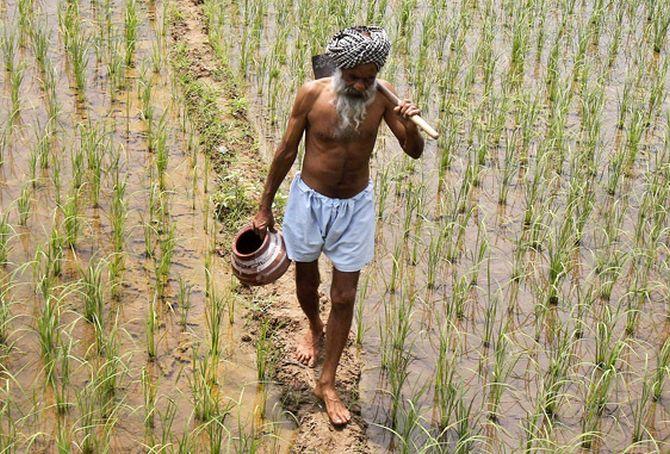A prolonged break in monsoon rains in most parts of the country is threatening to hit the yield of kharif crops.

It could even delay the upcoming rabi sowing.
Major agricultural states, such as Maharashtra, Madhya Pradesh, Andhra Pradesh, Punjab, and Gujarat, have witnessed a deficit of 30-80 per cent in southwest monsoon rainfall in August compared to the long-period average for the month.
Meteorologists see no big revival in monsoon rains from hereon, though they forecast “some activity” over the Bay of Bengal on September 5-6.
“Remember that in 70 per cent of the El Nino years, the deficit in monsoon rainfall in September is at least 10 per cent,” Madhavan Rajeevan, former secretary at the ministry of earth sciences and a well-known monsoon expert, told Business Standard.
The monsoon this year might end with a deficit of almost 8 per cent — the worst in eight years, a Reuters report said recently, quoting unnamed Met officials.
Rajeevan, however, said a clearer picture of the actual seasonal deficit would emerge after the first week of September.
The prolonged dry period has started impacting the standing kharif crops in several states.
And if it does not rain properly over the next 10-15 days, yields could go down in areas where irrigation facilities aren’t well developed.
In areas where irrigation is available, the growers’ costs will increase, according to experts.
A crop health survey done by the Indore-based Soybean Processors Association of India noted that there had been an unprecedented shortfall in rainfall in August.
It said that while the soy crop had held on to its own so far, rains were required immediately.
“Any delay in rains will be detrimental to the soybean crop in the entire country.
"The extent of yield loss will depend on the revival of rains, and it is premature to predict the overall crop today.
"All will depend on how the monsoon behaves in the next 45 days,” the association said in a statement.
SOPA’s analysis was for all the three major soybean-growing states — Madhya Pradesh, Maharashtra, and Rajasthan. Another state-wise analysis of the crop condition and the monsoon scenario by iGrain India, a commodity analysis firm, showed that in Rajasthan, major kharif crops like paddy, moong, soybean, cotton, bajra, and guar were badly in need of rains, while in neighbouring Madhya Pradesh, soybean was facing severe moisture stress.
In Gujarat, major crops such as soybean, tuar, bajra, paddy, groundnut, and moong needed water, and if it did not rain properly in the next 10-15 days, yields might start going down, it said.
“Also, if rains continue to remain weak in September and in the coming months, the forthcoming rabi harvest is also under threat,” Rahul Chauhan of iGrain India said.
Nearly 40 per cent of India’s annual food grain production is dependent on monsoon rains.
Pushan Sharma, director (research), CRISIL Market Intelligence and Analytics, said the current deficit in monsoon rains coupled with lower reservoir levels could have an adverse impact on crop yields.
A rainfall deficit is believed to have a negative impact on yields owing to poor vegetative growth, pest infestations, and problematic flower and pod setting across different crops, he said.
An analysis by CareEdge India, another research firm, showed that Maharashtra, Jharkhand, Karnataka, Odisha, West Bengal, and Tamil Nadu remained the most vulnerable to erratic monsoon rains, accounting for nearly a third of India’s agriculture GVA (gross valued added).
It said that though consumption demand was expected to pick up during the festival season, it would depend on the extent of the hit from the skewed monsoon rains.
A crop-wise analysis done by CRISIL showed that sucking pests like whitefly and thrips had heavily infested the cotton crop in Rajasthan.
In states like Telangana, Karnataka, and Maharashtra, the crop was reported to be in the vegetative stage following delayed planting.
The paddy crop season in states like Odisha and Chhattisgarh has been delayed by a month.
If dry conditions persist for another month, tillering of the crop is expected to be low, leading to poor panicle initiation and grain filling, lowering yields, according to the analysis.
“According to our on-ground interactions, if dry conditions persist in southern states for the next 15-20 days, farmers are likely to uproot the cotton crop and go for early sowing of maize, especially in Andhra Pradesh and Telangana.
"Additionally, in a few pockets of Maharashtra and Karnataka, farmers are likely to uproot the tur crop, following stunted crop growth, and go for early sowing of rabi jowar.
"In states like Rajasthan, farmers are expected to increase acreage under mustard as it does not require much irrigation and is also considered to be a hardy crop,” Sharma told Business Standard.











 © 2025
© 2025